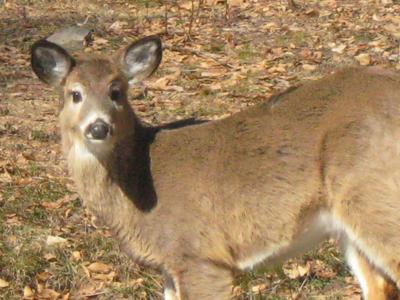After COVID-19 was discovered in white-tailed deer living in several states, New Hampshire wildlife experts are working to determine whether the virus has made its way into local deer populations.
Testing has confirmed COVID-19 infections among deer in several parts of the Northeast, including Massachusetts, New York and Pennsylvania, as well as in southern Ontario. While the virus has not yet been found in New Hampshire deer, the state soon expects to know whether samples taken from deer during the last two hunting seasons test positive for the coronavirus.
“New Hampshire collected samples for SARS-CoV-2 (the virus that causes COVID-19) testing during the 2021 and 2022 hunting seasons,” N.H. Fish and Game Deer Project Leader Becky Fuda told The Sentinel in an email. “Results are pending.”
Results from the 2021 hunting season are expected within the next couple of months, Fuda said, but there’s no estimate for when the 2022 results will be in.
In the fall of 2021, both New Hampshire and Vermont were asked by the U.S. Department of Agriculture’s Animal and Plant Health Inspection Service to begin testing white-tailed deer for COVID-19 as part of its national research into the subject. In a study of samples taken from deer in Illinois, Michigan, New York and Pennsylvania between January and March 2021, Agriculture Department researchers found that 40 percent contained COVID-19 antibodies.
Last year, samples from New Hampshire deer were collected from hunters during the five busiest days of the hunting season, Fish and Game deer biologist Dan Bergeron told the Associated Press.
“We have biologists at biological check stations and collect ages and weights annually,” Bergeron said. “This year, we also had them collect blood samples.”
White-tailed deer are just one of several animal species that have been found to carry COVID-19 since the pandemic began in early 2020. The virus has also been found in animals like mink, gorillas, otters and large cats, as well as in household pets including dogs, domestic cats, hamsters and ferrets, according to the Centers for Disease Control and Prevention.
While the disease can be passed between humans and animals, the CDC says the odds of a person catching the virus from an infected animal are considered low.
Fuda said the risk is no different when it comes to deer-to-human transmission. However, a Nov. 10 study published in the peer-reviewed Nature Microbiology journal found evidence that it may be possible.
Testing in southern Ontario showed that the genetics of one particular sample of the virus that was taken of a human more closely resembled the lineage of virus samples taken from white-tailed deer than those taken from other people.
The study “identified a human-derived sequence from Ontario that was highly similar and formed a well-supported monophyletic group with the white-tailed deer samples.” The analysis noted that at the time, Ontario aimed to analyze all confirmed COVID-19 samples collected from humans and that “no other genetically related human-derived samples were identified.”
With a low chance of contracting COVID-19 from deer, Fuda said hunters are advised to follow the same basic safety guidelines that Fish and Game regularly promotes. These include wearing rubber gloves and a face mask when butchering game, using a half-bleach, half-water solution to disinfect tools and work areas and to avoid shooting or handling animals that appear to be sick.
But when it comes to COVID-19 and deer, it might not be immediately clear whether the animal is infected with the virus.
“Initial evidence from a small captive study suggests infected deer are subclinical,” Fuda said, “that is, they do not have symptoms.”
The state guidelines for handling wild game also urge hunters to ensure they cook their meat thoroughly before consuming it, a process that is important because it kills most types of pathogens. While Fuda echoed this advice, she noted that no evidence has been found to suggest a person could contract COVID-19 from eating venison from an infected deer.
Much like the study of the virus’ effect on humans, research on its zoological impact is an ongoing process, and there’s a lot that isn’t known about the way the virus interacts with wildlife.
“SARS-CoV-2 infection in white-tailed deer populations is an emerging issue in wildlife research,” Fuda said, “and there [is] still much to be learned.”
Funding for the Monadnock Region Health Reporting Lab comes from several sources, including The Sentinel and several local businesses and private donors. We continue to seek additional support. The newsroom maintains full editorial control over all content produced by the lab.
These articles are being shared by partners in The Granite State News Collaborative. For more information visit collaborativenh.org.










(0) comments
Welcome to the discussion.
Log In
Keep it Clean. Please avoid obscene, vulgar, lewd, racist or sexually-oriented language.
PLEASE TURN OFF YOUR CAPS LOCK.
Don't Threaten. Threats of harming another person will not be tolerated.
Be Truthful. Don't knowingly lie about anyone or anything.
Be Nice. No racism, sexism or any sort of -ism that is degrading to another person.
Be Proactive. Use the 'Report' link on each comment to let us know of abusive posts.
Share with Us. We'd love to hear eyewitness accounts, the history behind an article.
Allow up to 24 hours for comment approval.